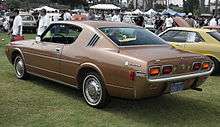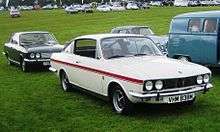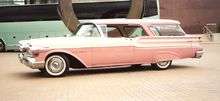Hardtop
A hardtop is a rigid form of automobile roof. They may be detachable for separate storing, retractable within the vehicle itself, or permanently attached to an auto lacking a center side-support known as a B-pillar. The term is also used to describe such vehicles, principally the last.
Hardtops may be either two-door or four-door, and tend to be more expensive and collectible than sedan models of the same vehicle.[1]
History
Early automobiles were open, described as having a "torpedo", "runabout", "phaeton", or "touring car" bodystyle. In time, some were made with rudimentary weather protection composed of a convertible-type canvas top and celluloid or isinglass side curtains. Some instead had removable rigid roofs, which were cumbersome and laborious to seasonally alternate.
Once fully closed bodies became the norm, it was considered fashionable to remove the central roof support post to give them a more open touring look. The first "hardtops" appeared during the 1915-1918 era as "convertible cars",[2] marketed as "touring sedans" or "Springfields" because many automakers had the bodies built by Springfield Body Company under license from Fisher Body and others.[2] The Springfield design featured folding upper frames on the doors and the rear glass frames is removable and stored under or behind the seats.[3]
By the time of World War I some automakers offered a removable roof, typically with a wood frame with a canvas or leather covering, that bolted onto touring car or roadster bodies.[2] They typically used side curtains like the conventional folding soft tops.
The elaborate cloth covered "California top" originated in the West, with either a permanent or a folding frame. These were designed with an emphasis on proportions to accent and provide distinctiveness to the appearance of the automobile, with colors adding special accents.[4] One objective of these aftermarket tops was to bring the cost of the closed car nearer to the prices of corresponding open cars.[5] Automobile dealers were encouraged to equip an open car with a California top to demonstrate that they were "cool and clean in summer, and warm and dry in winter."[6] The hard tops were frequently equipped with celluloid windows that retracted like a roller blind for open sided motoring offering a low-cost compromise between an open and closed car.[7]
The metal-framed "Carson top" was a popular addition for the 1930s Ford convertibles or roadsters because it turned these models into an almost instant hardtop.[2] The design mimicked a convertible top, but lacking the bulky folding mechanisms enabled the removable hardtop to have a much lower and more rakish profile.[8]
Following the ascendancy of steel tops for closed bodies in the 1930s, detachable hardtops with metal roofs began to appear. After World War II, the availability of new types of plastic and fiberglass allowed lighter, easier to handle hardtops with much of the strength of a metal top.
During the 1950s and 1960s, detachable hardtops were offered for various convertible sports cars and roadsters, including the 1955–1957 Ford Thunderbird and Chevrolet Corvette, as well as the 1963–1971 Mercedes-Benz W113 series of two-seaters. Because the convertible top mechanism is itself expensive, the hardtop was customarily offered as an additional, extra-cost option. On early Thunderbirds (and Corvettes through 1967), buyers could choose between a detachable hardtop and a folding canvas top at no additional cost, but paid extra for both.
Improvements in canvas tops have rendered the detachable hardtop less common in recent years, in part because the top cannot be stored in the vehicle when not in use, requiring a garage or other storage facility. Some open cars continue to offer it as an option. For example, some Mazda MX-5s are believed to have been delivered with an accessory hardtop, which is compulsory for some auto racing series.
Pillarless hardtops
The automotive usage of the term "hardtop" is most often applied for a fixed roof body style without a "b" or center pillar. They were sometimes called a "hardtop convertible" because they were designed to look like a convertible with the top raised. While some early models retained side window frames and B-pillars, by the 1950s, most were "pillarless hardtops." The designs omitted the B-pillar (the structural roof support behind the front doors) and configuring the window frames, if any, to retract with the glass when lowered.
Some hardtop models took the convertible look even further, including such details as simulating a convertible-top framework in the interior headliner and shaping the roof to resemble a raised canvas top. By the late-1960s such designs could be highlighted with an optional vinyl cover applied on the steel roof.
A pillarless hardtop is inherently less rigid than a pillared body, requiring extra underbody strength to prevent shake. Production hardtops commonly shared the frame or reinforced body structure of the contemporary convertible model, which was already reinforced to compensate for the lack of a fixed roof. With such a reinforced frame, a hardtop was stronger and stiffer than a convertible, but both weaker and (because of the reinforcements) heavier than a pillared body.
United States

.jpg)
.jpg)
.jpg)
There were a variety of hardtop-like body styles dating back to at least the 1920s. Chrysler Corporation built seven pillarless Town and Country hardtop coupes as concept vehicles in 1946, and even included the body style in its advertising that year.[9]
Mass-production of hardtops began with General Motors, which launched two-door, pillarless hardtops in 1949 as the Buick Roadmaster Riviera, Oldsmobile 98 Holiday, and Cadillac Coupe de Ville. They were purportedly inspired by the wife of a Buick executive who always drove convertibles, but never lowered the top. The hardtop became extremely popular in the 1950s, and by 1956 every major U.S. automaker offered hardtop coupés and four-door sedans in a particular model lineup. In 1955, Buick and Oldsmobile introduced the first four-door hardtop sedans. To popularize the introduction of the hardtop bodystyle, GM gave special trim designations for all their brands in North America. The term Seville was used for Cadillac, Riviera was used for Buick, Holiday was used for Oldsmobile, Catalina was used for Pontiac, and Bel Air was used for Chevrolet. For 1958, GM was promoting their fiftieth year of production, and introduced Anniversary models for each brand; Cadillac, Buick, Oldsmobile, Pontiac, and Chevrolet.[10] The 1958 models shared a common appearance on the top models for each brand; Cadillac Eldorado Seville, Buick Roadmaster Riviera, Oldsmobile Holiday 88, Pontiac Bonneville Catalina, and the all-new Chevrolet Bel-Air Impala.
In 1956, the first four-door hardtop station wagon was introduced by Rambler.[11]
In 1957, Mercury offered both two- and four-door hardtop wagons, called the Mercury Commuter, and was the only marque to do so. The type did not catch on, though, as most buyers considered wagons too boxy to benefit from the sporty look (or expensive enough to begin with). All disappeared from the market after 1964. The Facel Vega Excellence is a notable French example of a four-door hardtop from this period, noted for the huge opening with both doors on one side open and for sagging if all the doors were left open. The doors were designed for locking to the floor and not each other.
The hardtop body design emerged from 1946 to 1966 in both two- and four-door versions, while the two-door sedan body fell in popularity among buyers.[12] Throughout the 1960s the two-door pillarless hardtop was by far the most popular body style in most lines where such a model was offered. Even on family-type vehicles like the Chevrolet Impala, the two-door hardtop regularly outsold four-door sedans. Some car lines (such as the 1957 Cadillac and 1965-69 Corvair) only offered pillarless models with no sedans at all. So prevalent were true hardtops that Popular Mechanics described the new full-sized 1967 Oldsmobile Delmont models also included a "pillar" sedan.[13]
The hardtop began to disappear along with convertibles in the mid-1970s, partly out of a concern that U.S. federal safety regulations would be difficult for pillarless models to pass. The ascendancy of monocoque construction also made the pillarless design less practical. Some models adopted modified roof styling, placing the B pillars behind tinted side window glass and painting or molding the outer side of each pillar in black to make them less visible, creating a hardtop look without actually omitting the pillar. Some mid- to late-1970s models continued their previous two-door hardtop bodies, but with fixed rear windows or a variety of vinyl roof and opera window treatments.
The U.S. industry's last pilarless two-door and four-door hardtops were in the 1978 Chrysler Newport and New Yorker lines. Since then, no U.S. manufacturer has offered a true hardtop in regular production.
Japan

During the 1970s, Toyota produced the Toyota Crown in a pillarless two-door hardtop version, while Nissan followed suit with the Nissan Cedric and Nissan Gloria. Subaru introduced a new compact coupe as a genuine two-door hardtop with the Subaru Leone in 1971. The hardtop models were more expensive and luxurious than the sedan versions.
In the 1980s, Toyota continued the design with the Mark II, Nissan with its Laurel, and Mazda marketing its Luce. By the end of the 1990s, almost all hardtop designs disappeared as structural integrity standards continued to increase.
Europe

British pillarless hardtops included the Sunbeam Rapier and the Ford Consul Capri (355) which, unlike American models, sold fewer cars than their regular center pillar saloon versions.
British luxury carmaker Bentley (owned by Volkswagen Group) sells two true hardtop coupes, the Continental GT fastback, and the Brooklands coupe (2008). Some German manufacturers, including BMW and Mercedes-Benz have offered upscale pillarless hardtops. Renault produced a three-door hardtop between 2001 and 2003 in the form of the Avantime. Starting from 2012, Ford produces a five-door sliding hardtop in the form of the B-MAX; this vehicle is available in Europe, but not the United States.
The New Mini includes a blacked out B-pillar and fixed rear side glass, although it is labeled 'Hardtop' in the United States.
Concept cars
The concept versions of the Dodge Challenger and Chevrolet Camaro shown in 2006 were both pillarless two-door hardtops. However, the production versions of both include a blacked out B Pillar and fixed rear side glass. Another pillarless design was featured in the 2007 model concept for the Chrysler 300C. Cadillac exhibited a concept pillarless hardtop coupe, the Elmiraj.
Retractable hardtops
A retractable hardtop (also known as coupé convertible or coupé cabriolet) is a type of convertible that forgoes a folding textile roof in favor of an automatically operated, multi-part, self-storing roof where the rigid roof sections are opaque, translucent, or independently operable.
See also
Footnotes
- ↑ Mays, James C. (2006). Savvy Guide to Buying Collector Cars at Auction. Sams Technical Publishing. p. 67. ISBN 978-0-7906-1322-2. Retrieved 11 September 2011.
- 1 2 3 4 Howley, Tim (April 2006). "A History of Hardtops". Hemmings Classic Car. Retrieved 9 February 2014.
- ↑ Forbes, Kingston (1922). The principles of automobile body design, covering the fundamentals of open and closed passenger body design. Ware Bros. pp. 245–249. Retrieved 9 February 2014.
- ↑ Forbes, Kingston (1922). "The California Top". The principles of automobile body design, covering the fundamentals of open and closed passenger body design. Ware Bros. pp. 205–214. Retrieved 9 February 2014.
- ↑ Cullen, T.F. (1 February 1922). "Price situation results in many improvements in cars". Automobile Trade Journal. 25 (8): 28–29. Retrieved 9 February 2014.
- ↑ "A source of year 'round profit for dealers that sell Nash cars". Automobile Topics: 96. 25 February 1922. Retrieved 9 February 2014.
- ↑ Spajic, Igor (21 February 2012). "1925 Studebaker Big Six California Top". Vintage Car Heritage. Retrieved 9 February 2014.
- ↑ Auto Editors of Consumer Guide (19 September 2007). "Pisano/Ogden Buick: Profile of a Custom Car". HowStuffWorks.com. Retrieved 9 February 2014.
- ↑ Auto Editors of Consumer Guide (15 October 2007). "1946 Chrysler Town & Country Hardtop". HowStuffWorks.com. Retrieved 12 January 2016.
- ↑ Image of 50th Anniversary promotional photo
- ↑ "Rambler has everything new - even a hardtop wagon". Popular Mechanics. Vol. 105 no. 1. January 1956. pp. 116–117. Retrieved 12 January 2016.
- ↑ Norbye, John P. (October 1965). "How Car Buying Has Changed in 20 Years". Popular Science. 187 (4): 65. Retrieved 12 January 2016.
- ↑ "the 67's: Solid citizens of Detroit". Popular Mechanics. 126 (4): 114. October 1966. Retrieved 12 January 2016.
References
- Howley, Tim (April 1, 2006). "A History of Hardtops". Hemmings Classic Car. Hemmings Motor News. Retrieved January 18, 2009.
- Vance, Bill (July 18, 2007). Motoring Memories: Hardtop convertibles. Canadian Driver. Retrieved January 18, 2009.
